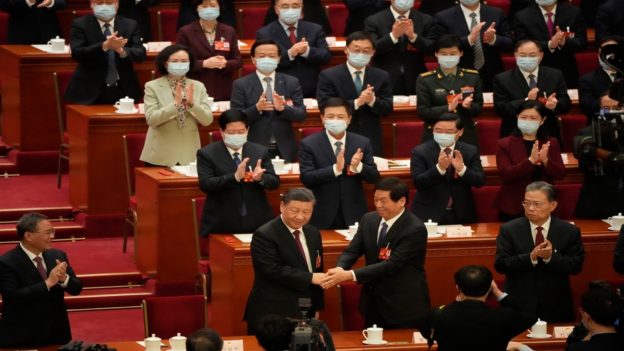With the formation of the Strategic Support Force (SSF), China is among the first to have an AI-based military SSF which is breaking into new-age military applications and AI Chips. Can India have one?
At the beginning of the year, when former Google CEO Eric Schmidt who is heading an Artificial Intelligence (AI) commission urged the US government to boost its AI skills to counter China, including by pursuing “AI-enabled” weapons, it rippled across with signs of warning.
Artificial Intelligence (AI) is shaping modern warfare like none. And among the countries which are leading the change with sheer speed is China. So much so that the People’s Liberation Army (PLA) lays the ground for a Strategic Support Force (SSF) which is responsible for military informatization construction and defence in cyberspace.
Under the SSF, Chinese military strategies put entire elements of AI-based autonomous machinery into two divisions, including space, cyberspace, information warfare, and psychological warfare. The SSF now form those functions: the Space Systems Department, which is home to all space-related missions, and the Network Systems Department, which houses the PLA’s information warfare activities.
While the advancement of AI is widely pursued by other nations for their national interest, China’s pursuit of AI for military applications is beyond any accountability and bereft of ethical debates on its fallout. As FBI Director Christopher Wray recently warned that he was “deeply concerned” about the Chinese government’s artificial intelligence program, asserting that it was “not constrained by the rule of law.”
Also, with the numerous hacking operations which trace their roots to China, its advancement in artificial intelligence may result in global hacking operations, intellectual property theft and repression of dissidents inside the country and beyond.
The SSF: A new kind of warfare
The SSF was founded in 2015 as the PLA’s fifth force along with other ground forces, navy, air, and rocket forces. China’s military doctrine defines its innovation-driven development strategy and highlighted that it will adopt differentiated strategies and asymmetric paths. That is about focusing on technologies that are already making an impact on the battlefield – a kind of asymmetric one.
In fact, China’s national strategy for innovation-driven development clearly points out the research on such technologies as humanlike machine intelligence, natural interaction and virtual reality, microelectronics, and optoelectronics.
In addition to that, the PLA calls out the R&D and comprehensive application of technologies in specific areas like cloud computing, the Internet of things (IoT), Big Data, high-performance computing, and mobile intelligent terminals; expand R&D and promotional efforts for independent hardware and software products and network security technology, such as integrated circuits and industrial controls, providing safeguards for China’s economic transformation and upgrading and the protection of national network security.
On top of that systems and components including sensors for artificial intelligence for military decisions and its applications are developed at China’s National University of Defence Technology and its Academy of Military Science.
AI: Military-civil fusion
Largely, AI-enabled systems and processes depend on the semiconductor. Most of the development also takes place in the civil space—the commercial arena. China’s leadership has prioritized semiconductors as a strategic area and planned to invest over $100 billion within the next decade.
“It is to counter the AI superiority that the U.S. takes over China, says Professor Amit Das,” Head of the Center of AI, ICFAI University.
While the U.S. still enjoys a dominant market share in leading-edge GPU (Graphics Processing Units) and FPGA (Field Programmable Gate Array) design, AI-relevant ASICs (Application Specific Integrated Circuits), Chinese firms are breaking into.
Take a look at these two Chinese AI chip unicorns Cambricon and Horizon Robotics, which have designed and launched AI chips within just a few years, including Huawei’s Ascend 910, for processing vast amounts of data for algorithms. In fact, based on such dramatic achievement, a report suggests that China is on track to possess as much as 30 percent of the world’s data by 2030.
How the PLA wants to achieve this?
By Propelling the very concept of military-civil fusion in marine, space, network and other new fields. The SSF is carrying out the formulation and consolidation of general military-civilian standards. The strategy is to implement a two-way conversion of military-civilian standards and encourage the integration of military-civilian standards systems.
AI for Indian Military
While India is a late entrant, its armed forces have been gearing for addressing AI in military applications. The Indian Armed Forces has included Autonomous Weapons Systems (AWS) and Lethal Autonomous Weapons Systems (LAWS) in their domain.
In fact, last year, Air Force Chief V.R. Chaudhri emphasized that the service was working with the DRDO, academia, and industry to develop niche capabilities in the cyber and AI domains.
The IAF has defined AI applications in the areas of threat monitoring, training, data and intelligence fusion, and decision support. The IAF has been operating UAVs for various Intelligence, Surveillance and Reconnaissance (ISR) missions.
Lately, the Army has put a lot of thrust into AI, setting a Centre for Excellence (CoE) of AI in Madhya Pradesh. Some of the integration happened under the current Chief who is from Corps of Engineers and greatly understands the needs and gaps as well. The CoE will focus on key integration and applications of AI, Cyber with Quantum Key Distribution, Quantum Communication, Quantum Computing, and Post-Quantum Cryptography.
How the army should be using AI is well laid out by the former Chief of Army Staff General M M Naravane as he outlined key areas: Situational awareness; the fusion of sensors; faster decision-making; and autonomous weapons systems.
Despite all such efforts, there is a lack of coherence among the forces and one unified roadmap for AI in military applications and its development.
As General Naravane called out the changes in combat doctrine, organisation and structure of the Army if it is to effectively leverage AI. And new military doctrinal orientation for our integrated theatre command.
https://www.financialexpress.com/business/defence-ai-makes-way-for-chinese-strategic-command-can-india-have-one-3123090/





